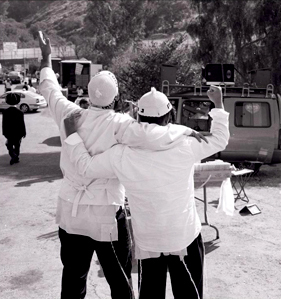
Shared Sacred Sites Project
Shared Sacred Sites is a collaborative project that seeks to develop a rubric for the description, classification, analysis, and publication of work relating to spaces and locations used by multiple, disparate communities for religious purposes. The project is composed of several sub-projects that individually address different and particular difficulties in the study of shared sacred sites and that combine to form an important, updated, and modern survey of the unique features, mechanisms, and adaptations of coexistence found in the communities involved with shared sacred sites.
Valentina Napolitano, Toronto University
Valentina Napolitano is the author of Migration, Mujercitas and Medicine Man: living in Urban Mexico (University of California Press, 2002) where she explores alternative modernities, urbanities in transformation, prisms of belonging and gendered subject formation in Guadalajara, with particular reference to contested Catholic evangelization, medical pluralism, gendered politics of dwelling and the celebration of the quinceñeras. Building on her Mexicanist expertise she has also explored issues of gendered embodiment and masculinity in Mexican transnational migration to California and the subtle politics of transculturaltion of Asian and complementary medicine in urban Mexico. More recently her research has focused on affect, transnational returns of histories and bioreligiosity that come to the fore at a postcolonial conjuncture that it is the emergence of Catholic Latin American Missions in Rome, Italy. She is then exploring the politics of affect that are nested at the interface of transnational migration, Roman Catholic Church politics/pedagogies on migration and Catholic political theologies of the ‘human', with an ethnographic focus, among others, on the Virgin of Guadalupe and the Sacred Heart. Her future projects include a study of economies of sanctities and the transnational circulation/mediation of Catholic relics, reliquaries and affect at the intersection of Christian medieval histories and current life-worlds.
Claudia Liebelt, Bayreuth, Germany
Claudia Liebelt worked with Filipina care and domestic workers’ pilgrimage journeys and sanctifying encounters in Israel. She is currently immersed in a study of pilgrimage to the Turkish shrine of Meriem Ana Evi. Following the visions of an Augustinian nun in Germany, this site on Mount Koressos (near Ephesus) was (re)discovered in the late 1800s and again in the second half of the twentieth century.
David Lehmann, Cambridge University, UK.
David Lehmann has been studying religion in Latin America since the mid-1980s (Democracy and development in Latin America: economics, politics and religion in the postwar period, 1990, and Struggle for the Spirit, 1996) and has also undertaken major research in Israel (Remaking Israeli Judaism –with Batia Siebzehner - 2006) and on marriage among ultra-Orthodox Jews. He is currently engaged in a study of Messianic congregations in Brazil, Israel and the UK: this is a growing global movement and the study tracks the multi-directional interpenetration and borrowing of Jewish and evangelical styles and rituals and beliefs among a range of congregations whose members have come variously from Jewish and evangelical backgrounds.
Curtis Hutt, University of Nebraska at Omaha
Curtis does research on historical and contemporary topics, including pilgrimage to and within Israel/Palestine. He has recently published an article titled “Pilgrimage in Turbulent Contexts” which examines ritual change in Jewish, Christian, and Islamic pilgrimages over the last one hundred years. Curtis has published several articles on method and theory in the study of religion and has a book titled John Dewey and the Ethics of Historical Belief: Religion and the Representation of the Past (SUNY Press, 2013). Included amongst the places that Curtis and his students have researched are: the Qubbat al-Sakrah and the City of David in Jerusalem, Nebi Musa, the St. Barbara Church in Aboud, the Church of St. George in Lod, and Nazareth Village. He has studied journeys to these sites paying close attention ritual activity, inter-religiosity, the production of symbolic capital, and the role played by religious and non-religious specialists in the cultivation of pilgrims’ experiences.
Oren Golan, Haifa University
Oren Golan has been engaged in the study of digital religion since 2009, with an emphasis on Jewish communities in the US and Israel and the ways that new media has challenged their boundaries and practices. He is currently a lecturer in the Faculty of Education at the University of Haifa, Israel.
Golan is a primary investigator in the Learning in a Networked Society (LINKS) group that has been awarded by the state to become an Israeli Center of Research Excellence (ICORE). http://www.links.org.il/en
He has also recently been awarded a Marie Curie grant for his study of the digital religion amongst the ultra-Orthodox community.
http://cyber-youth.blogspot.co.il/
